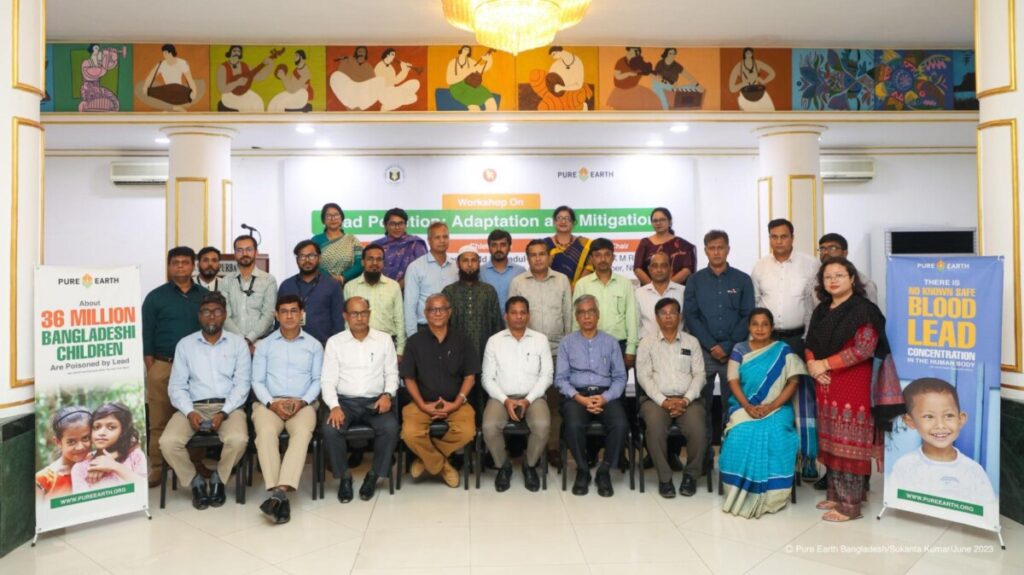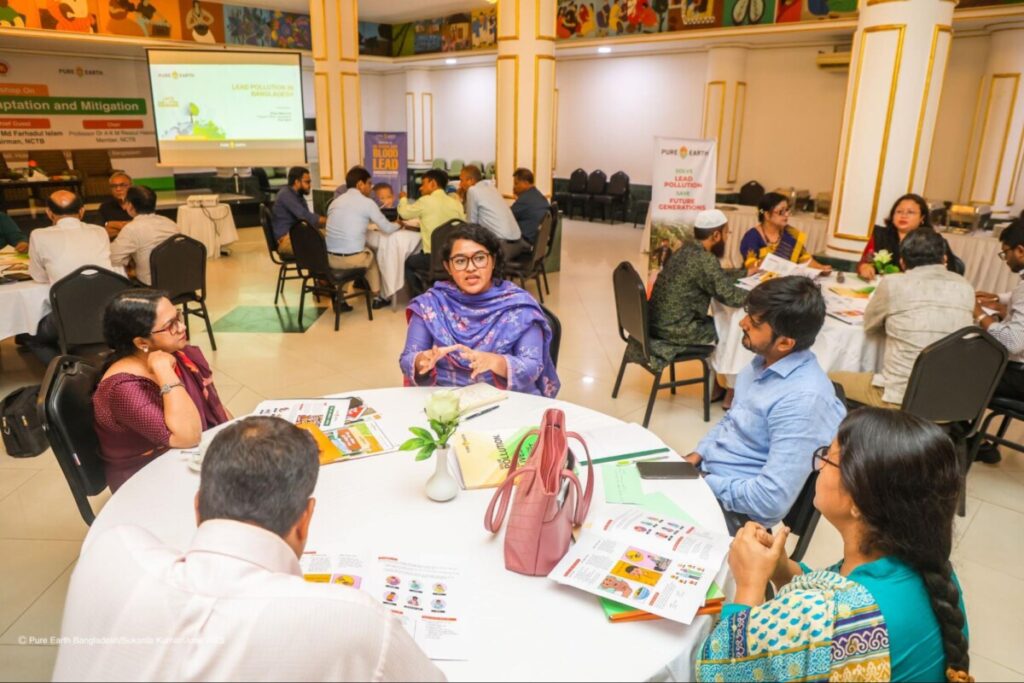Pure Earth Bangladesh plans to protect their country’s future by accelerating nationwide awareness through the inclusion of lead pollution into the national curriculum. Learn more in this post from Bushra Humaira Sadaf, Senior Communications Manager, Pure Earth Bangladesh.
Protecting Our Future

Children are the future. They will be leading us in the coming days. Nurturing and helping them reach their potential is our duty, which is in jeopardy today as about 36 million children in Bangladesh are exposed to lead poisoning. It is a critical issue that demands our attention and requires massive public awareness. Lead exposure poses significant risks, specially to children. It causes a wide range of hazardous effects, including reduced intelligence, behavioral problems, and learning difficulties.
Lead contamination is more widespread than we may realize. It can be found in unexpected places, such as wall paints, toys, cookware, some spices, and foods. This prevalence highlights the urgent need for heightened awareness and preventive measures. Pure Earth Bangladesh wants to drive this cause by including lead pollution into the primary school syllabus of the national curriculum, which will reach about 16 million primary school students. This, hopefully, will have a domino effect from students to parents and parents to greater communities around the country.

Adapting The National Curriculum
Addressing this situation, Pure Earth Bangladesh arranged a workshop titled Lead Pollution: Adaptation and Mitigation at Hotel Purbani Int’l Ltd Dhaka, Bangladesh, with the National Curriculum and Textbook Board (NCTB) to share the information and knowledge about the impact, sources, and solutions to lead pollution on 21st June 2023.
NCTB develops a national curriculum for pre-primary to higher secondary levels of education in Bangladesh. Curriculum experts, researchers, and teachers from different schools and colleges from all around the country came together under one roof to discuss various ways to incorporate lead pollution into the national curriculum. The workshop hosted various interactive group works, discussions, presentations, and video screening to introduce the impact of lead pollution to all. Pure Earth also provided suggestive materials with a book chapter and a teacher’s handbook guide for review and feedback by the experts and teachers.
Stressing the importance of including lead pollution in the national curriculum, Pure Earth Bangladesh Country Director, Dr. Mahfuzar Rahman said, “There are about one million teachers in our country. Incorporating the adverse impact of lead into the national curriculum can help teachers teach the students and educate the parents on the effects of lead. Adding lead pollution to the curriculum can be an impactful way to reach every household with the lead-related awareness message to reduce the risk.”

The guests shared many ideas and recommendations during the workshop ranging from developing age-appropriate classes to building the capacity of the teachers by adding the lead issue in different training courses. The participants suggested designing interactive activities for children to understand the risk of lead exposure better and sharing the information with proper references to ensure authenticity to make them more acceptable.
They noted that lead pollution is very relevant to add to the current curriculum as it is aligned with the Sustainable Development Goals (SDGs). Chairman of NCTB and Chief Guest, Professor Md Farhadul Islam, expanded on it by saying that the curriculum is being redesigned with a fresh perspective and interactive activities. He encouraged all the participants to generate innovative ideas to prevent lead pollution.

Lead Pollution: An Imminent Danger To Our Children
The most concerning issue with lead pollution is its impact on children’s brains. About 36 million Bangladeshi children are exposed to lead through various sources, it can be found in various household items and daily commodities including spices, aluminum and ceramic cookwares, toys, wall paints, etc. Children play around the house, they are more likely to scratch walls and bite the toys.
Faisal Mahmood, Program Officer of Pure Earth Bangladesh, presented on these issues of lead pollution, its impacts, and sources during the workshop to showcase the impact and severity of the situation. Despite being an imminent threat to our future, there are ways to tackle this situation, noted Dr. Mahfuzar Rahman, Pure Earth Bangladesh Country Director. He also added that we should engage teachers and parents to reach out to children and efficiently sensitize the community.
Safety And Inclusion of All Children
Bangladesh has a large population of children belonging to different communities, social and economic strata. Content for the curriculum will need to pay attention to children’s needs and understanding. Salim Uddin, Research Officer, NCTB, stressed including information in such a way that will apply to different diaspora around the country, reflecting their culture and daily practices. “The national curriculum book reaches every corner of the country and to the children who live in very different contexts, e.g., children from the Chittagong hills will have a very different context to children living in the capital city.”
Children, being most vulnerable to lead pollution, need to be protected at home and outside. This raised the concern of the point of contact these children have at home and school. The safety of children can be ensured by teaching them about lead poisoning early on as they get exposed to lead in their home. During the question-and-answer sessions after the presentation and video screening, different issues transpired as everyone added their opinion.
Different recommendations like listing the activities and situations through which children ingest lead, and specifying lead sources for children came up during discussions.

Capacity Building of Teachers
Building capacity for teachers is a fundamental step to raising awareness of lead pollution as they are the frontline in engaging with children and parents. Teachers must have adequate knowledge and training, a willingness to make change, and the tools to teach children about lead pollution. One participant stressed this issue during the discussion. AKM Reazul Hassan, Member, NCTB, guided it by suggesting that we can disseminate more activities in the curriculum. He suggested curating textbooks for students, providing a guide or handbook for teachers, and a guide or training manual for guardians. He suggested that teachers may have monthly meetings with parents. He also proposed that Pure Earth could develop an app through which teachers can communicate with them.
Participants suggested building the capacity of the teachers by adding the lead issue in different training courses and institutions such as in the Diploma program curriculum and Upazila Resource Centre. Including environmental law in the teacher’s handbook content was another suggestion.
After the Q&A session, there was a discussion session for which the participants were divided into four groups. During the sessions, participants deep-dived into ways of engaging teachers and students through the handbook and book chapter provided to them.

Further Research On Lead Pollution
Currently, there is a great gap in knowledge as there is no sufficient data on sources through which lead enters our bodies. There is a need to work further on the literature and research on lead pollution. One of the participants remarked on the importance of authenticating and specifying information sources in handbooks or book chapters. As information is included in the national textbook, they suggested that authenticity has to be verified. With further research, there is also a need to list and elaborate on the possible sources of lead access to children, e.g., window grills and shiny toys, and provide an alternative source of use. For example, aluminum cookware is commonly used in Bangladesh. As there is a possibility of high lead in aluminum cookware, alternative sources of cooking need to be specified and included in the content. Some participants observed the need to use appropriate words in children’s books which also need further exploration and analysis.

Raising Awareness Of A Looming Danger
Lead poisoning is detrimental not only to children but also to adults. The impact of lead goes beyond the early years. In a recent study by the American Health Association, lead pollution has been linked to cardiovascular disease and kidney failure. The damage it causes to the human body is irreparable. We need to raise public awareness about how lead is increasing the environmental and health risks in our communities.
After preliminary discussion, participants were divided into different groups to discuss and present on how to raise awareness among children, teachers, and parents. During the presentation, participants from different groups provided innovative ways to reach out to parents, students, and teachers. One group suggested making a list of the kinds of lead-based painted toys that are potentially risky for the children and the safe options for the children, and then the teachers will communicate the list with caregivers and parents.

Some suggested, designing interactive activities for children to better understand the risk of lead exposure by age and learning-appropriate content for different grades, and adding pictorials and stories to make younger children understand the issues.
For teachers, the suggestions were to conduct household visits and parents-teachers meetings to share the messages. Use mass communication, e.g., radio and television media, documentaries, and video clips, to make the teachers aware. Teachers should talk about and prohibit certain habits of children which may cause lead ingestion, e.g., biting batteries or window grills. Teachers must reach out to the parents through Parents-Teachers Meetings (PTM), annual days, home visits, and the Parent-Teacher Association (PTA). In these meetings, what is lead, the sources, and the effects of lead can be discussed. Lead information with audio-visual materials can also be disseminated through government-facilitated apps.

Curriculum and Beyond
There was a strong consensus among participants to add the lead pollution topic in pre-primary to make the parents aware of lead since little children are more vulnerable to lead pollution. Participants suggested a 3-phase inclusion in different subjects: Social Science, Science, and Mental and Physical Health. It could be a cross-cutting project. In the pre-primary level, we can introduce the term ‘lead’ and appropriately increase the content according to their age and learning goals.
Besides the curriculum, teachers can discuss the issue through poster presentations, leaflet distribution, and video shows in the school, establish environmental clubs, and observe Lead Poisoning Prevention Week at the school level. During education week, students can organize campaigns about lead pollution. There are environmental clubs in schools. Some students from the clubs can form a ‘lead team’ where they can work on different campaigns on lead pollution.
While sharing the closing remarks, the Chair of the workshop, Dr. A K M Reazul Hassan, Member, NCTB, said, “As we are designing our curriculum, we are taking our education beyond the classroom and local perspective. We can include lead pollution in different chapters of different subjects such as Social Science, Science, and Physical Science. As our curriculum follows the Sustainable Development Goals (SDG) so this should include the environmental pollution issue. We understand that we can scale this up and need to include this in higher education as well.”

Way Forward
As we move forward into developing an informative and interactive curriculum for the national level, Pure Earth will work to incorporate the feedback into the teacher’s handbook guide and book chapter, which will be shared in the next follow-up workshop.
The revised chapter could be introduced in the new edition of the 2024 primary-level textbook mainly for the students of 5th grade. Pure Earth will also develop audio-visual materials for the NCTB mobile app so teachers can learn about the various impacts of lead pollution. Furthermore, Pure Earth will also plan to conduct workshops around the country at the district level to reach the grassroots teachers at a national level.





